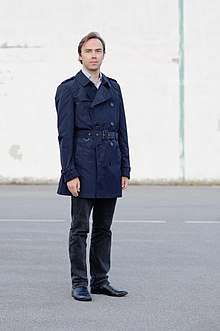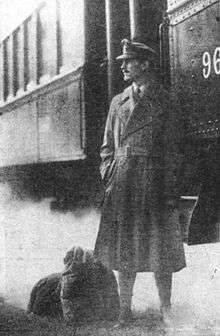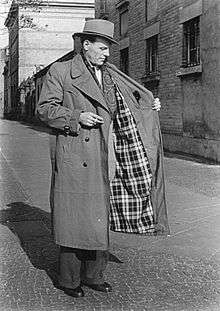Trench coat
A trench coat or trenchcoat is a coat variety made of waterproof heavy-duty cotton gabardine drill, leather, or poplin.[1] It generally has a removable insulated lining, raglan sleeves, and the classic versions come in various lengths ranging from just above the ankles (the longest) to above the knee (the shortest).[1] It was originally an item of clothing for Army officers (developed before the war but adapted for use in the trenches of the First World War, hence its name) and shows this influence in its styling.

Traditionally this garment is double-breasted with 10 front buttons, and has wide lapels, a storm flap, and pockets that button-close.[1] The coat is belted at the waist with a self-belt, as well as has straps around the wrists that also buckle (to keep water from running down the forearm when using binoculars in the rain). The coat often has shoulder straps that button-close; those were a functional feature in a military context. The traditional color of a trench coat was khaki, although newer versions come in many colors.
History
World War I

The trench coat was developed as an alternative to the heavy serge greatcoats worn by British and French soldiers in the First World War. Invention of the trench coat is claimed by two British luxury clothing manufacturers, Burberry and Aquascutum, with Aquascutum's claim dating back to the 1850s. Thomas Burberry invented gabardine fabric in 1879 and submitted a design for an Army officer's raincoat to the United Kingdom War Office in 1901.[2][3][4][5]
The trench coat became an optional item of dress in the British Army, and was obtained by private purchase by officers and Warrant Officers Class I who were under no obligation to own them.[6] No other ranks were permitted to wear them. Another optional item was the British Warm, a wool coat similar to the greatcoat that was shorter in length, also worn by British officers and Warrant Officers Class I as an optional piece.

During the First World War, the design of the trench coat was modified to include shoulder straps and D-rings. The shoulder straps were for the attachment of epaulettes or other rank insignia; the D-ring was originally used for attaching map cases, swords, or other equipment to the belt, and there is a popular myth that it was for the attachment of hand grenades.
This latter design was dubbed "trench coat" by the soldiers in the front line. Many trench coats had large pockets for maps, and cleverly placed flaps and vents to deal with the odour associated with earlier rubber coats.
A range of waterproof coats was designed and sold during wartime that incorporated War Office requirements with traditional aspects of leisurewear. What became known as the "trench coat" combined the features of a military waterproof cape and the regulation greatcoat designed for British officers.[7] Many veterans returning to civilian life kept the coats, which became fashionable for both men and women.
World War II
During the Second World War, officers of the United Kingdom continued to use the trench coat on the battlefield in inclement weather. Other nations also developed trench coat style jackets, notably the United States and the Soviet Union, and other armies of continental Europe such as Belgium, France, Germany, Greece, the Netherlands, Poland (and are often seen in war zone photographs in the 1939-40 era, even worn by troops on the attack), although as the war progressed, in the field shorter "field jackets" became more popular, including garments such as the Denison smock used by British commandos, paratroopers, and snipers and the M1941/M1943 field jackets used by the US Army. These garments were shorter and more practical than the trench coat, and as such they allowed the wearer to be more mobile.[8]
A typical trench coat is a 10-buttoned, double-breasted long coat made with beige, black, khaki, or tan fabric. Trench coats often have cuff straps, raglan sleeves, shoulder straps, and a belt. The trench coat was typically worn as a windbreaker or as a rain jacket, and not for protection from the cold in winter or snowy conditions (although many come with removable wool liners for additional warmth, they are usually not as warm as an overcoat). Period advertisements from World War I reveal that the trench coat was sized to wear over the British Warm, to offer water protection when the temperature was cold enough to require the heavier coat, which explains the traditionally generous sizing of trench coats; however, makers in recent years have resized trench coats downwards to conform more closely to overcoat sizing, as the two coats, trench and overcoat, would rarely if at all be worn together today. [9]
Later
Trench coats have remained fashionable in the decades following World War II. Their original role as part of an army officer's uniform lent the trench coat a businesslike respectability, although many prefer to tie the belt in front (rather than use the buckle) to project a more casual look than strict military dress. Humphrey Bogart's Rick Blaine from Casablanca[10] and Peter Sellers' Inspector Clouseau wore the trench coat in the public eye. Often, a fedora or an ushanka (during colder weather) was also worn. In the 1960s, radical intellectuals wore trench coats over black turtleneck sweaters, while some Mods wore trench coats as fashionable overcoats, as an alternative to the fishtail parka or crombie. Streakers and flashers often prefer trench coats since they conceal the wearer's lack of undergarments and can be opened quickly when the exhibitionist is ready to expose him or herself.
While similar, the heavy metal and Goth fashion trend of black oilcloth dusters are usually (incorrectly) referred to as trench coats.[11] Early media reports of the 1999 Columbine High School massacre initially associated the perpetrators (Eric Harris and Dylan Klebold) with members of the "Trenchcoat Mafia", a group of outcasts who allegedly wore conspicuous black Australian oilcloth dusters. In the copycat W. R. Myers High School shooting days later, it was rumored the shooter had worn a trench coat. In the wake of these incidents, many public schools in the US forbade students from wearing trench coats, both because of their cultural associations and on the grounds that they could be used to conceal weapons.[12][13]
See also
- Coat (clothing)
- Duster (clothing)
- Fedora
References
- Foulkes, Nick (2007). The Trench Book. Assouline. ISBN 2759401634.
- Chastain, Sue (1985-12-04). "TRENCHANT COAT CUFFS MAY FRAY AND BUTTONS MAY POP, BUT A TRUE BELIEVER WON'T ABANDON HIS BURBERRY". Chicago Tribune. p. 40.
- Streeter, Claire (1989-04-05). "Caught up in a classic Born in the trenches of WWI, the Burberry survives as the quintessential raincoat". Chicago Tribune. p. 18.
- Fashion, Burberry Store. "Trench Coats". Burberry. Retrieved 2016-03-04.
- https://dieliving.com/history-of-trench-coats-not-just-for-flashers/
- "Trench Coats In Demand" (PDF). New York Times. 1917-08-29.
- Tynan, Jane (2011). "Military Dress and Men's Outdoor Leisurewear: Burberry's Trench Coat in First World War Britain". Journal of Design History. 24 (2). pp. 139–156.
- Hilton, Frank (1983). The Paras. British Broadcasting Corporation. ISBN 0-563-20099-5.
- "Barker's advertisement". Stars and Stripes. 1918-11-01.
- "Bogart-Casablanca". The Golden Era. Retrieved 2009-08-09.
- "Heavy Metal Fashion Returns". METALEATER. 2006-03-24. Archived from the original on 2006-10-17. Retrieved 2008-08-01.
- "The Denver Post Online - Columbine - Tragedy and Recovery". extras.denverpost.com.
- Rachel Rodriguez; Christina Zdanowicz. "Nothing the same after Columbine, say students, teachers". edition.cnn.com.
External links
